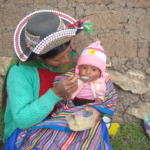


HealthBridge Foundation of Canada
Bolivia
8/2007—8/2009
Small-scale agriculture interventions that focus solely on improving production usually do not have an impact on the diet or health of participating households. In order to improve diet and health, agriculture interventions need to invest broadly, including investments in community/household relationships, physical and natural resources, financial capital and, most importantly, human capital, especially nutrition education. Those agriculture interventions which integrate a nutrition education component are more likely to have a positive health outcome. Although there has not been a great deal of research on the subject, supporting literature can be found in a report and published paper by HealthBridge and a report by the World Bank . The role of this project, therefore, is to support the integration of nutrition interventions into two of the Andes CCRP agriculture-research projects, in Ecuador and Bolivia; and to document the impact of these integrated interventions.
INIAP in Ecuador have been promoting lupin and quinoa production for years and more recently they have promoted the consumption of these crops via community recipe days, radio infomercials, home visits and a regular presence in the communities, and facilitating the inclusion of quinoa and lupin into the local school lunch program. World Neighbors in Bolivia has conducted research to identify suitable legume varieties for the harsh environments of Northern Potosi and also to characterize child feeding practices. HealthBridge had the responsibility for advising on the technical content of the promotional messages in Ecuador, for advising on the feeding practices research in Bolivia, and for leading monitoring programs measuring changes in diet and health in both settings.
The goal for each partner of this project is:
INIAP in Ecuador: To increase food security, nutrition, and income generation in the target communities through the improvement and promotion of quinoa and lupin.
World Neighbors in Bolivia: To expand the role of green manures, forages, and grain legumes in crop rotations; to build local capacity for agricultural innovation; to improve maternal and child nutrition by building on gains in crop productivity from participatory research on legumes in crop rotation.
HealthBridge: To strengthen the promotion of improved health and nutrition through improved production of healthy foods, especially lupin and quinoa, and to strengthen the monitoring of health changes in a scientifically rigorous manner, by contributing to the efforts of INIAP and World Neighbors Bolivia.
The progress in both Ecuador and Bolivia is proving consistent with the literature. In Ecuador there has been an integrated nutrition intervention, i.e., they combined an agriculture intervention promoting cultivation of quinoa and lupin with a nutrition intervention promoting consumption of quinoa and lupin. By using this approach, consumption of lupin and quinoa has increased to approximately 3-fold the levels in the control communities. The intervention in the intervention communities has now halted and in May 2009 we will measure consumption levels 10 months post-intervention. In Bolivia there has not yet been a nutrition intervention (planned to be rolled out starting in September 2008), and there have been no measured changes in diet or health. In May and October 2009 we will measure changes in diet and child growth after one year of nutrition intervention, integrated with the agriculture intervention.
